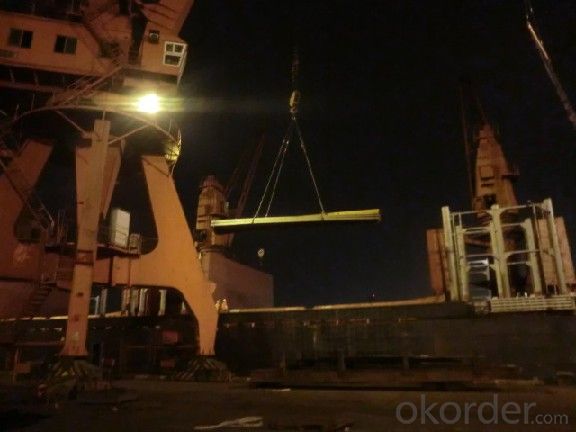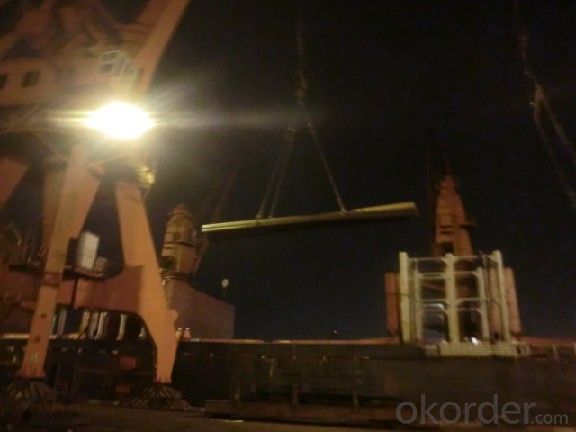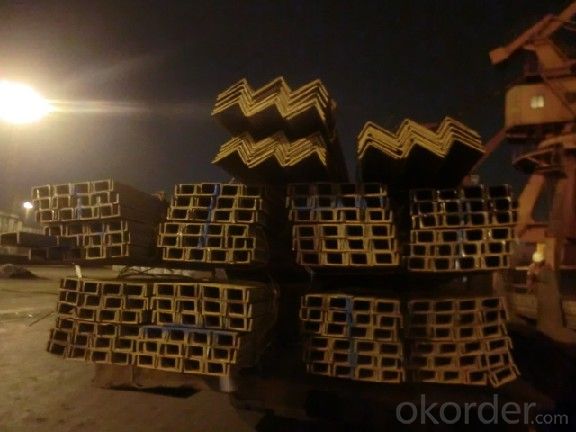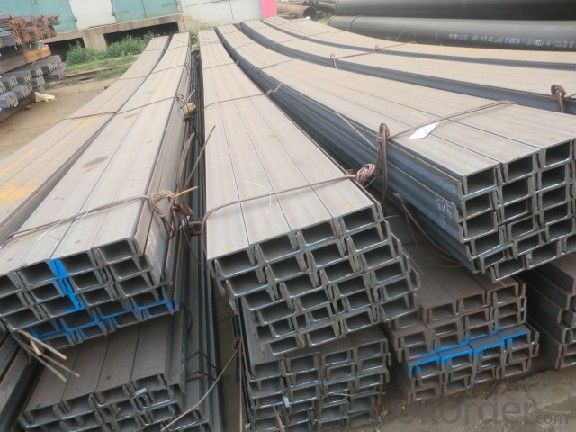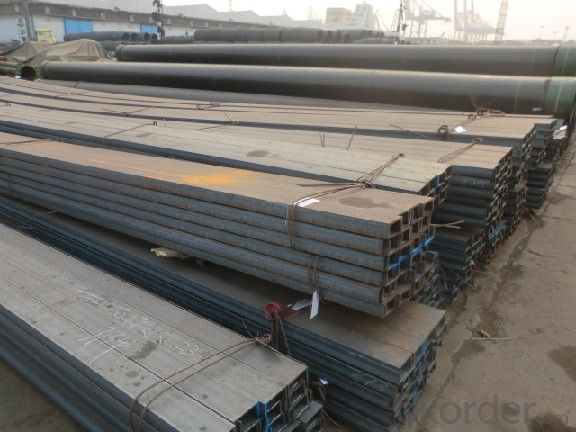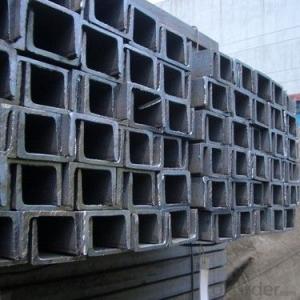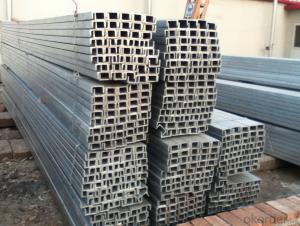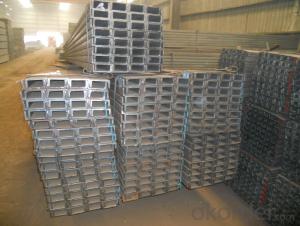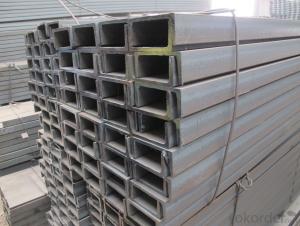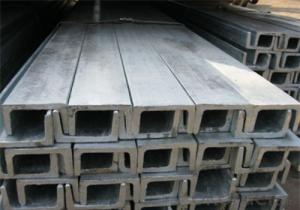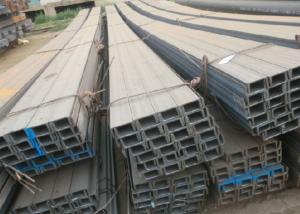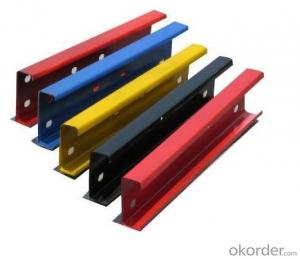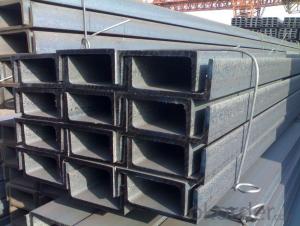high quality low carbon steel channel JIS
- Loading Port:
- Tianjin
- Payment Terms:
- TT OR LC
- Min Order Qty:
- 5 m.t.
- Supply Capability:
- 1000 m.t./month
OKorder Service Pledge
OKorder Financial Service
You Might Also Like
Product Description:
Specifications of MS Channel:
1.We supply high quality MS Channel at reasonable price, including Chinese standard, Japanese standard and so on.
Standard | GB/JIS |
Material Grade | Q235,SS400 |
Technique: | Hot Rolled |
Sizes as per chinese standard: | 50*37*4.5mm - 300*89*11.5mm |
Sizes as per japanese standard: | 50*25*3mm – 200*80*7.5mm |
Length: | 6meter, 9meter, 12meter |
Note: 1.we are also competent to provide our customers other MS Channel based on other sizes according to customer’s requirements.
2. The length of our ms channel could be cut into other meters as per customer’s requirements. For example, the channel in 6meters could be cut into 5.8meters in order to be fit in the 20ft container.
2. The detailed sections of MS Channel as per GB standard.are shown in the table-1:
GB U CHANNEL | Standard | Sectional | Dimension |
| Mass: |
| (mm) | (mm) | (mm) | (mm) |
|
50X37 | 50 | 37 | 4.50 | 7.0 | 5.438 |
63X40 | 63 | 40 | 4.80 | 7.5 | 6.634 |
80x43 | 80 | 43 | 5.00 | 8.0 | 8.045 |
|
|
|
|
|
|
100x48 | 100 | 48 | 5.30 | 8.5 | 10.007 |
120x53 | 120 | 53 | 5.50 | 9.0 | 12.059 |
140x58 | 140 | 58 | 6.00 | 9.5 | 14.535 |
140x60 | 140 | 60 | 8.00 | 9.5 | 16.733 |
|
|
|
|
|
|
160x63 | 160 | 63 | 6.50 | 10.0 | 17.240 |
160x65 | 160 | 65 | 8.50 | 10.0 | 19.752 |
|
|
|
|
|
|
180x68 | 180 | 68 | 7.00 | 10.5 | 20.174 |
180x70 | 180 | 70 | 9.00 | 10.5 | 23.000 |
|
|
|
|
|
|
200x73 | 200 | 73 | 7.00 | 11.0 | 22.637 |
200x75 | 200 | 75 | 9.00 | 11.0 | 25.777 |
|
|
|
|
|
|
220x77 | 220 | 77 | 7.00 | 11.5 | 24.999 |
220x79 | 220 | 79 | 9.00 | 11.5 | 28.453 |
|
|
|
|
|
|
250x78 | 250 | 78 | 7.00 | 12.0 | 27.410 |
250x80 | 250 | 80 | 9.00 | 12.0 | 31.335 |
250x82 | 250 | 82 | 11.00 | 12.0 | 35.260 |
|
|
|
|
| |
280x82 | 280 | 82 | 7.50 | 12.5 | 31.427 |
280x84 | 280 | 84 | 9.50 | 12.5 | 35.823 |
280x86 | 280 | 86 | 11.50 | 12.5 | 40.219 |
|
|
|
|
|
|
300x85 | 300 | 85 | 7.50 | 13.5 | 34.463 |
300x87 | 300 | 87 | 9.50 | 13.5 | 39.173 |
300x89 | 300 | 89 | 11.50 | 13.5 | 43.883 |
Table-1
3. The chemical composition of HR Channel Steel according to Q235B is shown in Table-2.
Alloy No | Grade | Element(%) | ||||
C | Mn | S | P | Si | ||
Q235 | B | 0.12-0.20 | 0.3-0.7 | ≦0.045 | ≦0.045 | ≦0.3 |
Table-2
Note: we are able to present our customers relevant SGS test report for chemical composition of HR Channel Steel.
4. The mechanical property of HR Channel Steel according to Q235B is shown in Table-3-1 and Table-3-2
Alloy No | Grade | Yielding Strength Point(Mpa) | |||
Thickness(mm) | |||||
≦16 | >16-40 | >40-60 | >60-100 | ||
≧ | |||||
Q235 | B | 235 | 225 | 215 | 205 |
Table-3-1
Alloy No | Grade | Tensile Strength(Mpa) | Elongation After Fracture(%) | |||
Thickness(mm) | ||||||
≦16 | >16-40 | >40-60 | >60-100 | |||
≧ | ||||||
G235 | B | 375-500 | 26 | 25 | 24 | 23 |
Table-3-2
Note: we are able to present our customers relevant SGS test report for mechanical property of MS Channel as customer’s request.
Applications of MS Channel:
The MS Channel can be applied to construction of warehouses, workshops, sport stadiums and car parks etc.The hot rolled channel steel belongs to carbon structural steel which is applied to in the field of construction and machinery.In details, the hot rolled channel steel is usually used for arch-itechtural structure, and they could be welded in order to support or hang a vari-ety of facilities. They are also usually used in combination with I beam. Generally,the hot rolled channel steel we supply must possess perfect welding property, riveting property and mechanical property and so on.
Package & Delivery of MS Channel:
1.The hot rolled channel steel will be packed in bundle with steel wire at each end of every bundle and color marking in order to help the customer to recognize his goods more easily at sight.
2. And the hot rolled channel steel could be loaded into 20ft or 40ft container, or by bulk cargo.If the weight of each bundle reaches more than 3.5 mt, the loading by break bulk cargo should be choosed.When the weight of each bundle reaches less than 3mt, the loading by container should be choosed.
3.As for the transportaion from mill to loading port, the truck will be usually used. And the maximum quantity for each truck is 40mt.
4.All in all, we could do in accordance with customer's request
- Q: Are steel channels suitable for the oil and gas manufacturing industry?
- Yes, steel channels are suitable for the oil and gas manufacturing industry. Steel channels are commonly used in various industries, including oil and gas, due to their durability, strength, and versatility. In the oil and gas industry, steel channels are used for various applications such as supporting pipelines, constructing oil rigs, and creating structural frameworks for equipment and machinery. Steel channels provide excellent load-bearing capabilities, high resistance to corrosion and extreme temperatures, and can withstand harsh environmental conditions common in the oil and gas sector. Additionally, steel channels can be easily fabricated, welded, and assembled, making them a preferred choice for constructing complex structures in the oil and gas manufacturing industry. Overall, steel channels offer the necessary characteristics required for the oil and gas industry, making them a suitable choice for various applications in this sector.
- Q: How do steel channels contribute to the versatility of a building design?
- Steel channels contribute to the versatility of a building design by providing structural support and flexibility in construction. They can be used as beams, columns, or support members, allowing for the creation of various architectural shapes and configurations. Steel channels also offer high strength and durability, enabling the construction of larger and more complex structures. Their lightweight nature makes them easy to handle and install, while their corrosion resistance ensures long-lasting performance. Overall, steel channels enhance the design possibilities and adaptability of a building, accommodating different aesthetic preferences and functional requirements.
- Q: How do steel channels perform in seismic zones?
- Due to their exceptional performance under seismic loads, steel channels are widely used in construction in seismic zones. The shape of steel channels, characterized by their wide flanges and narrow depths, offers high strength and stiffness, making them resistant to lateral forces and vibrations caused by earthquakes. The ductility and high yield strength of steel channels enable them to dissipate and absorb seismic energy effectively. This means that they can undergo significant deformations without failing, allowing them to endure the intense ground shaking experienced during earthquakes. Moreover, the seismic performance of steel channels can be enhanced through design and reinforcement techniques. For instance, additional stiffeners or braces can be incorporated to improve their resistance to bending and torsion. These reinforcement methods help to distribute seismic forces more evenly throughout the structure, minimizing the risk of localized damage. Furthermore, steel channels have the advantage of being prefabricated, ensuring their manufacturing quality and accuracy. This facilitates efficient and precise installation, leading to reduced construction time and costs. In conclusion, steel channels have consistently demonstrated their reliability and effectiveness in seismic zones. The combination of their remarkable strength, ductility, and ability to dissipate seismic energy makes them the preferred choice for engineers and architects when designing structures in earthquake-prone areas.
- Q: Can steel channels be used in railway infrastructure?
- Yes, steel channels can be used in railway infrastructure. Steel channels are commonly used in the construction of railway bridges, tracks, and support structures due to their strength, durability, and ability to withstand heavy loads. They provide structural support and stability, making them ideal for use in railway infrastructure projects.
- Q: How do steel channels contribute to sustainable design in buildings?
- Steel channels play a crucial role in promoting sustainable design in buildings due to their numerous advantages in terms of durability, recyclability, and energy efficiency. Firstly, steel channels are known for their exceptional durability, which contributes to the longevity of buildings. Unlike other materials, steel channels have a high resistance to corrosion, weathering, and pests. This durability reduces the need for frequent maintenance and replacement, leading to a decrease in the overall environmental impact of the building. Secondly, steel channels are highly recyclable. At the end of a building's life cycle, steel channels can be easily dismantled and recycled, ensuring that they do not end up in landfills. This recycling process requires significantly less energy compared to the production of new steel, resulting in reduced carbon emissions and conservation of natural resources. Furthermore, steel channels enable energy-efficient designs in buildings. Due to their high strength-to-weight ratio, steel channels allow for the construction of lighter structures, reducing the amount of material required. This, in turn, leads to a decrease in energy consumption during construction and transportation. Additionally, steel channels can be easily integrated with insulation systems, improving the building's thermal performance and reducing the need for excessive heating or cooling. Moreover, steel channels can be prefabricated off-site, minimizing construction waste and improving productivity through precise manufacturing. This process reduces the environmental impact of construction activities, such as noise, dust, and energy consumption. Lastly, steel channels provide design flexibility, allowing architects and engineers to create innovative and sustainable structures. Their versatile nature allows for the implementation of various design techniques, such as modular construction and adaptive reuse. These strategies contribute to sustainable development by optimizing space, reducing material waste, and promoting resource efficiency. In conclusion, steel channels are an essential component of sustainable design in buildings. Their durability, recyclability, energy efficiency, and design flexibility contribute to the reduction of environmental impact, conservation of resources, and promotion of sustainable practices in the construction industry.
- Q: What are the different load combinations for steel channels?
- Load combinations for steel channels are dependent on the particular design criteria and application being considered. However, there are several typical load combinations for steel channels, including: 1. Dead Load: This refers to the constant load that is applied to the structure. It encompasses the weight of the steel channel itself, any permanent fixtures or equipment, and the self-weight of other components. 2. Live Load: This is the variable load that is exerted on the structure due to occupancy, usage, or temporary equipment. Examples can include people, furniture, vehicles, or machinery. 3. Wind Load: This is the lateral force that is exerted on the structure by wind. It takes into account factors such as wind speed, exposure category, height, and other criteria specified by applicable building codes or standards. 4. Snow Load: This refers to the additional weight that is placed on the structure due to snow accumulation. It considers factors such as snow density, anticipated snowfall, and design elements provided by relevant codes or standards. 5. Seismic Load: This is the force that is generated by earthquakes or seismic activity. The magnitude of the seismic load depends on factors such as the seismic zone, soil conditions, and the structural response to such events. 6. Impact Load: This encompasses the sudden and dynamic loads that occur as a result of accidental events, such as vehicle collisions or equipment failures. The magnitude and duration of the impact load depend on the specific circumstances. 7. Temperature Load: This includes the thermal expansion and contraction of the steel channel caused by temperature variations. It is taken into account for structures that are exposed to extreme temperature changes. 8. Combination Load: This involves considering multiple loads that act simultaneously or in combination with each other. Different load combinations are determined based on the governing design codes or standards that apply to the specific project. It should be noted that the specific load combinations and their associated factors may differ based on the design codes, project requirements, and the professional judgment of the structural engineer. Therefore, it is essential to consult the appropriate design standards and guidelines to determine the suitable load combinations for a particular steel channel application.
- Q: Can steel channels be used in modular data centers?
- Yes, steel channels can be used in modular data centers. Steel channels provide structural support and stability, making them suitable for use in modular data centers where robust and durable construction is required.
- Q: Can steel channels be used for balcony railings?
- Yes, steel channels can be used for balcony railings. Steel channels are strong and durable, making them suitable for providing support and safety on balconies. They can be customized to fit the specific dimensions and design requirements of the balcony. Additionally, steel channels are corrosion-resistant and can withstand harsh weather conditions, making them a reliable choice for outdoor applications. Whether it is for residential or commercial purposes, steel channels offer a versatile and aesthetically pleasing option for balcony railings.
- Q: What are the different types of corrosion protection for steel channels?
- There are several different types of corrosion protection methods available for steel channels, depending on the specific requirements and environmental conditions. Some of the common methods are: 1. Galvanization: This is one of the most popular methods of corrosion protection for steel channels. In this process, the channels are coated with a layer of zinc, which acts as a sacrificial anode and prevents corrosion by corroding itself instead of the steel. 2. Powder coating: Powder coating involves applying a dry powder to the channels and then baking it in an oven to create a protective layer. This method provides excellent corrosion resistance and can also enhance the aesthetics of the channels. 3. Epoxy coatings: Epoxy coatings are commonly used for corrosion protection in aggressive environments. These coatings form a strong and durable barrier against moisture and chemical exposure, preventing the steel channels from corroding. 4. Paint coatings: Paint coatings can provide a cost-effective solution for corrosion protection. Multiple layers of paint are applied to the steel channels, creating a barrier between the metal and the corrosive elements in the environment. 5. Hot-dip galvanizing: Similar to galvanization, hot-dip galvanizing involves immersing the steel channels in a bath of molten zinc. This process provides a thicker and more durable layer of protection compared to regular galvanization. 6. Cathodic protection: Cathodic protection is a technique used to protect steel channels by making them the cathode in a corrosion cell. This is achieved by connecting the channels to a sacrificial anode, such as zinc or magnesium, which corrodes instead of the steel. 7. Stainless steel: Using stainless steel channels is another effective way to prevent corrosion. Stainless steel contains a high percentage of chromium, which forms a passive oxide layer on the surface, protecting it from corrosion. It is important to choose the appropriate corrosion protection method based on factors such as the environment, expected lifespan, and cost considerations to ensure the longevity and durability of steel channels.
- Q: What are the different bending techniques for steel channels?
- Steel channels can be bent using various techniques, depending on the desired outcome and the equipment at hand. Some popular bending techniques for steel channels are as follows: 1. Roll Bending: By passing the steel channel through a series of rolls, it can gradually be shaped into the desired form. Roll bending can be performed in different ways, such as pyramid rolling, which utilizes three rolls to create a pyramid shape, or double pinch rolling, which employs two rolls for a more uniform bend. 2. Press Bending: Utilizing a press machine, force is applied to the steel channel, resulting in its bending. This technique is often employed for smaller channels or when a tighter radius is required. Press bending can be executed with the aid of a V-die, ensuring a smooth bend, or a bottom bending die for more intricate shapes. 3. Induction Bending: This technique involves heating the steel channel to a specific temperature using an induction coil, making it more pliable. Once heated, a bending machine or a set of rolls is used to bend the channel. Induction bending is commonly used for large or thick steel channels that necessitate precise and consistent bends. 4. Rotary Draw Bending: A mandrel and a set of dies are employed in rotary draw bending to bend the steel channel. The mandrel is inserted into the channel to prevent wrinkling or collapsing during the bending process. This technique is often utilized for tight radius bends or when maintaining the structural integrity of the channel is of utmost importance. 5. Stretch Bending: By clamping the ends of the steel channel and applying force, it can be stretched over a mandrel or a form. Stretch bending is commonly employed for larger channels or when creating long, sweeping curves. Each bending technique offers its own advantages and limitations, and the choice of technique depends on factors such as the desired bend radius, the thickness of the steel channel, and the available equipment. It is crucial to consider the specific requirements of the project and seek guidance from professionals in order to determine the most appropriate bending technique for steel channels.
Send your message to us
high quality low carbon steel channel JIS
- Loading Port:
- Tianjin
- Payment Terms:
- TT OR LC
- Min Order Qty:
- 5 m.t.
- Supply Capability:
- 1000 m.t./month
OKorder Service Pledge
OKorder Financial Service
Similar products
Hot products
Hot Searches
Related keywords





